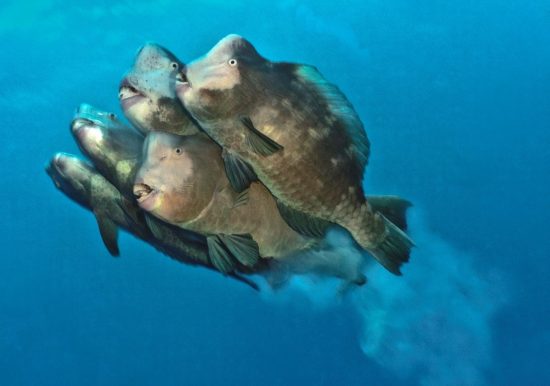




The green humphead parrotfish (Bolbometopon
muricatum) is one of the diver's favourite fishes. A school of more than 50
of these fishes swimming by is simply breath-taking.
The green humphead parrotfish is one of
the largest parrotfish species. These reef giants weigh nearly 50 kilogrammes
and measure almost 1.5 metres across. They are found at the reefs of the Indian
and Pacific Oceans, the Red Sea in the west and Samoa in the east, and even all
the way to the coasts of Japan's Yaeyama Islands in the north and Australia's
Great Barrier Reef in the south.
Being primarily coral-eaters, the bumphead
parrotfish's distinctive feature is their beak-like teeth that partially cover
their fleshy lips. At the back of their throats are pharyngeal teeth that they
use to grind down hard coral.
Every year, during certain phases of the
lunar cycle, the fish aggregates in large numbers to spawn. Little is known
about the species' reproductive cycles – until several years ago when a
aggregation of over a thousand individuals was discovered in Palau. This was
the largest aggregation of bumphead parrotfish to date.
Moon Cycle
This event takes place at every new moon
phase, during which the parrotfish gather at a sandy reef slope in the Rock
Islands at Palau. The reason why the parrotfish has chosen this specific
location to spawn is still unclear.
The Dive
As the sun rises, the parrotfish emerge
from the shallows, coming together like a waterfall from the lagoon where they
had spent the night. At first, it's a loose, rhythmic formation that gets
progressively denser. Soon, it is a large mass that meanders around the reef.
Occasionally, there is a chomping sound as some individuals steal a bite as the
events unfold.
After a while, the alpha males show their
dominance by swimming upwards, extruding their fins out. At this time, their
heads turn white. Often, you can hear them banging their heads with one
another, signalling that the action is about to start.
Then, the huge school of parrotfish swims
off into the blue water. All their heads – both males and females – have turned
white. Their bands and bars down their flanks have emerged. The ritual dance of
these sexually driven fish thus begins.
The females shoot up to the surface,
closely followed by males in hot pursuit. This can last up to an hour, after
which the school of parrotfish dispense back to their resident populations, and
things go back to normal.
One theory for this strange behaviour is
that the females are trying to find the fastest and strongest males to mate
with, so their offspring would have the best genes.
As the parrotfish dispense, the water has
turned a murky, cloudy mass of gametes, which drift along with the outgoing
tide, ready to begin the first part of their life cycle. After five to six
days, they will start to feed on algae and copepods something they will do for
the next three months or so. Those that survive will return to the lagoon to
take refuge in the shallows, remaining there for the next two to three years.
After this time, they will join the adults in the outer reefs where they
themselves will start to reproduce.
Being
slow to mature, the bumphead parrotfish start their reproductive life when they
are about 50 centimetres. Considering that they can live up to 40 years old and
reach 1.5 metres across, this is relatively slow and may not to be able to
sustain the species' population growth.
Although occasionally hunted by large
sharks, the biggest threat to the bumphead parrotfish is people. The parrotfish
habitually return to the same place to sleep, making them very vulnerable to
spear fishermen, especially after the invention of the underwater dive light.
They are classified as “vulnerable” by the
IUCN (International Union for Conservation of Nature), and are on the Red List
of Threatened Species. Moreover, they are part of the “Management Unit Species”
(MUS) plan for the coral reef ecosystems of the Western Pacific, which deals
with fish management.
In 1994, Palau has banned the bumphead
parrotfish's export; and in 2005, the country has gone on to impose a complete
ban on the fishing of this species in their waters.
 Mares
Mares 15th January 2016
15th January 2016 Palau
Palau